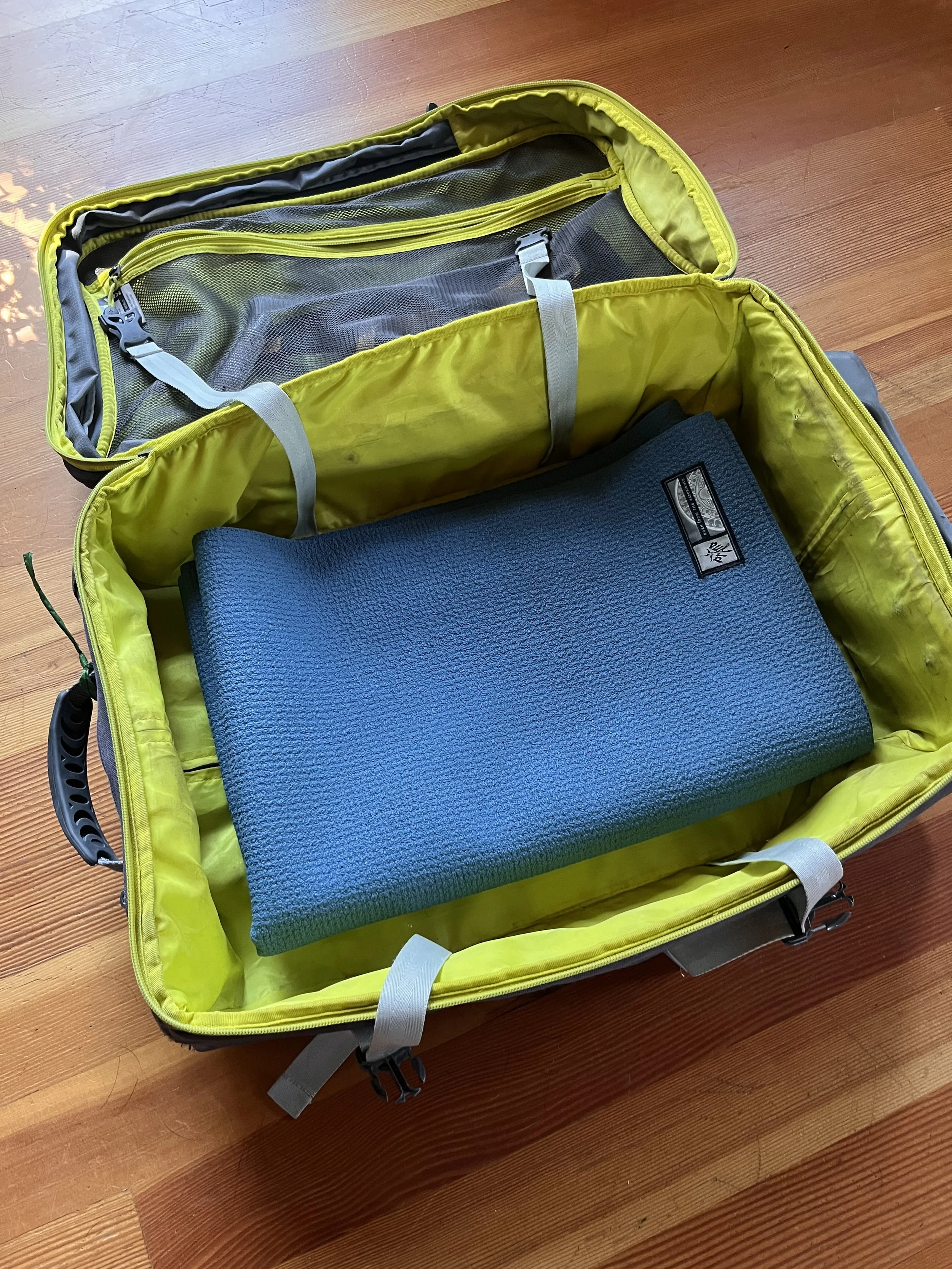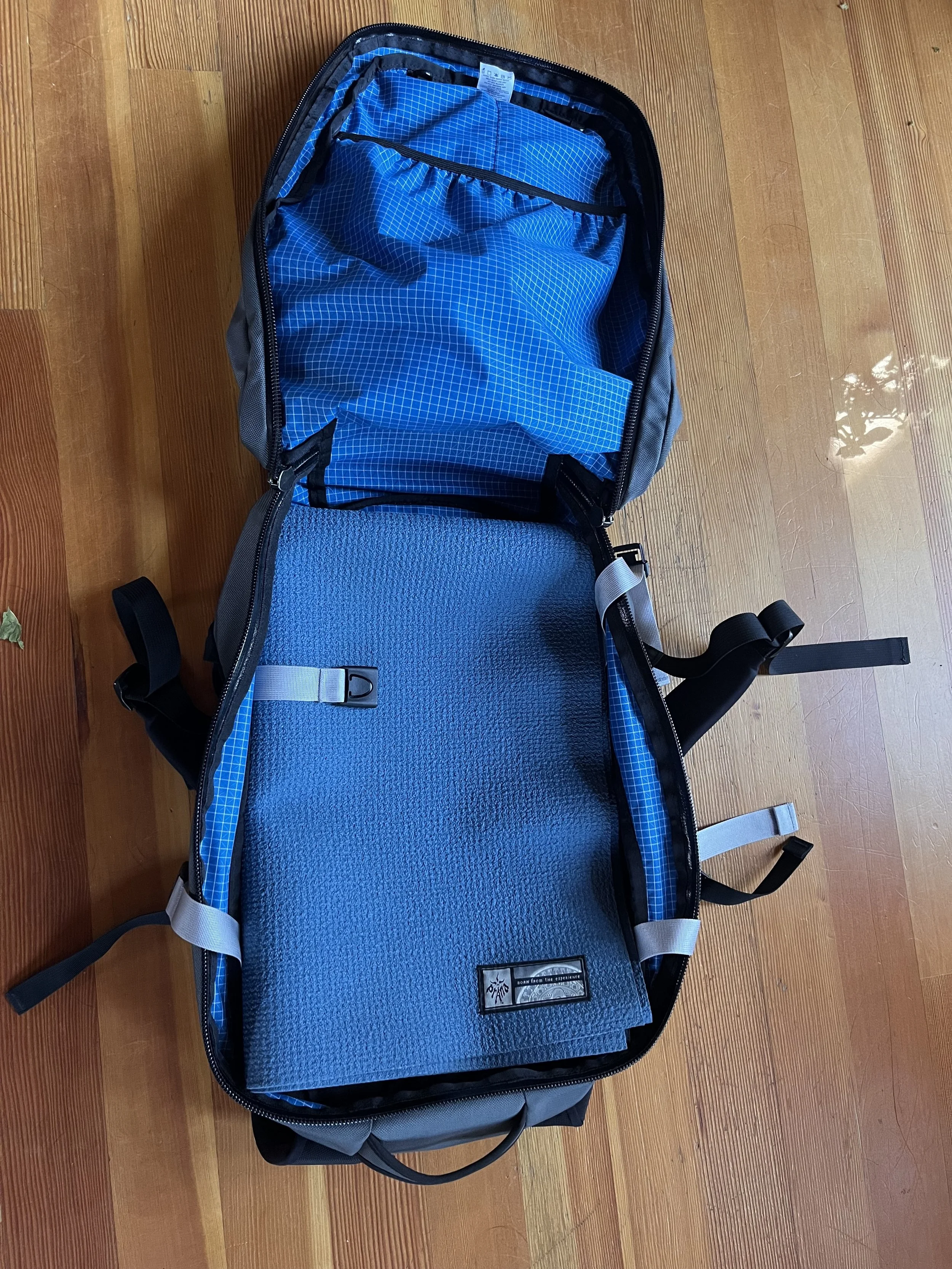Traveling with Your Yoga Props: What to Pack and How to Pack
With summer travel upon us, I thought it would be helpful to share some recommendations for traveling with your yoga props. Obviously, if you're traveling by car, it can be easy to throw a yoga mat and a few props into the mix, but if you're travelling by plane, train or bus, bringing yoga props can be a bit of a challenge.
If you're lucky to be headed to a yoga retreat center in the Pacific Northwest or further afield of course they will likely have all of these yoga props and more, so no need to pack them. But if you're traveling elsewhere (such as my upcoming retreat to Croatia with Drishti Journeys), bringing a few props will help you to maintain at least a minimum of practice while you're on the road.
Selfie of me from Venice in June 2023 with my travel set up. Checked luggage rolling bag suitcase, carry on backpack and crossbody purse. My backpack can either be worn as a backpack or it can be attached to the handle of my rolling bag when it's extended, allowing me to take some weight off my back or allow my back to breathe if it's hot outside.
Carry-On vs. Checked Bag: How to Travel With Yoga Props
The Basics: Your Mat
When it comes to packing a yoga mat, you have two options:
Pack your mat into your suitcase (recommended)
Carry your yoga mat as part of your carry-on configuration (less recommended)
Option 1: Packing Your Mat in Your Suitcase
If you're someone who checks your bag when you fly, you can bring a more generous size suitcase and either put a rolled yoga mat into your bag or fold it and put it on the bottom or top of your bag.
A standard yoga mat is 68" by 24". If you fold it right, you can get it down to 17" x 12" if it's not more than 4mm thick. This should fit into a checked luggage size bag easily. At this size, it will fit into a carry-on size suitcase as well.
There is also an option to purchase a travel-specific mat, which takes out some of the padding, and thus the bulk of the mat, making it lighter and easier to fold down or roll up even smaller. However, if you end up practicing on a hard surface, you may find the travel mats at 2 or 1.5mm a bit lacking for any postures where your bones might press down into the floor. Try a travel mat at home to see if you can tolerate it if you're used to a 4mm or a thicker yoga mat. Most travel mats are also so light that they shift around underneath you as you practice, which is bothersome.
For extra padding, you could purchase and bring a yoga towel or use a bath or beach towel from your hotel or vacation rental to add padding when needed. Or just bring a more standard thickness yoga mat as you're used to at home and allow that extra space in your luggage.
Option 2: Carrying on Your Mat
As for carrying on your mat in a separate yoga bag, here’s why I don't recommend doing this:
With your yoga mat separate from your main suitcase and primary carry-on, you are more likely to forget your yoga mat in the overhead bin when you leave the plane (I speak from my own experience and that of my students!).
Airlines on full flights may count it as one of your carry-on items.
I recommend keeping all travel luggage as compact and simple as possible, making sure that everything fits inside your purse, carry-on and checked luggage, leaving your hands free. So no carrying a water bottle or attaching a neck pillow to the outside of your carry-on (as I see a lot of people do). A yoga mat bag is awkward to carry in addition to all of your other luggage.
Think... "If I had to run or move quickly to make a connecting flight, could I do so with the combination of luggage that I have?"
If you must bring your mat as part of your carry-on, one recommendation is to find a backpack that has tie-down options that could accommodate your yoga mat so that it's firmly attached to your bag. But I recommend instead finding a way to fold it and put it inside your carry-on or checked luggage if at all possible.
Yoga Straps and Why I Never Travel Without One
When I travel, I always bring two additional props:
An 8- or 10-foot strap
A lacrosse or tennis ball
These two items take up such minimal space and weight, are useful and versatile that they make it worthwhile. They also allow you to do specific practices that are beneficial when you're traveling.
The ball you can use to roll out your weary feet if you're walking more than you're used to. And the strap you can use to do the supta padangusthasana cycle, which is so beneficial for tired legs and for jet lag. Plus, both of these practices are grounding, which counteracts the ungroundedness that we feel when we travel.
If you have room, of course bring a block or two. But hopefully the yoga retreat location where you are headed will have a few extra towels, perhaps a strong, stable chair, and some couch cushions or pillows that you can make use of. We can get creative and problem solve how to recreate our familiar poses in an unfamiliar setting. This is the wonderful thing about yoga, it can be done anywhere. In fact, you can probably do without even a yoga mat in many locations. I have a simple seated routine that I can do as long as I have a carpeted floor or can create padding with blankets or towels.
Staying Grounded While Traveling
Doing even a little yoga or meditation practice as we travel helps to keep us aligned, not just physically, of course, but mentally and emotionally. It keeps us more mindful throughout our day(s) of travel, more inwardly flexible with the unpredictability that travel brings.
When we miss a connection, or are struggling with exhaustion or indigestion, our yoga and meditation practice is good medicine. You can read more about traveling and the power of mindfulness through the link below.
Travel Props I Recommend
Travel yoga mat:
Deluxe - 2mm by Manduka - $75
Economy - 1.5mm (1/16") by Hugger Mugger - $27
Yoga towel:
Manduka (comes in regular and long) - $68 for regular
Hugger Mugger - $55
Strap:
Get an 8- or 10-foot one with a metal D-Ring (not plastic!). 6-foot straps are often too short for the practices I like to do myself and offer in my sessions.
Hugger Mugger - $17
Manduka also has high quality straps with metal D-Rings.
Lacrosse or tennis ball:
You can get these from any nearby sporting goods retailer. Or if you want to splurge, look into myofascial release balls from Yoga Tune Up or another resource.
My travel set-up with a yoga mat
My suitcase (similar to this one by Rick Steves): Rick Steves Rolling Bag
My travel yoga mat folded inside my carry-on backpack (made by Tom Bihn in Seattle) - my mat was made by Prana and, unfortunately, is no longer made by them.
Joanna Dunn is a yoga and meditation teacher, retreat leader, and somatic movement guide based in Leavenworth, Washington.
Joanna’s yoga retreats are open to all abilities and body types. If you have any questions please email Joanna directly HERE.




